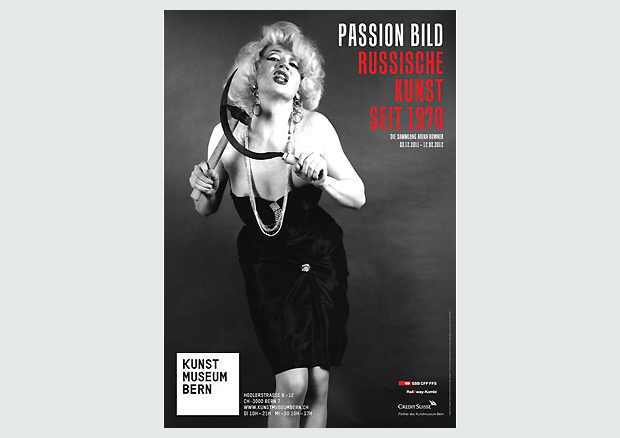Passion and Painting. Russian Art since 1970
The Transition from the Soviet Union to Russia
The Kunstmuseum Bern is now showing one of the key collections of Russian contemporary art. Arina Kowner’s collection comprises over 200 works of art by 48 artists from 1970 to 2008. The focus of the collection is the period of social and political transition in the former East Bloc from 1984 to 1996, presenting an art-historical documentation of unique epochal change. The show is part of the series of exhibitions in Bern on Russian contemporary art.
Arina Kowner, a collector based in Zurich who originally came from
Russia, knew or is acquainted with many of the artists whose works she
now owns. As Kowner puts it herself: "Acquiring a work of art is mostly
linked to a personal encounter." Correspondingly she describes her
collection as a "great documentation of memories that had a vital impact on my life."
A dialogue that transgresses borders
Leningrad and
Moscow were the two centers in which artists from all over the Soviet
Union came together. The exhibition reflects the different art styles
and approaches as well as the typical subject matter for each of the two cities.
In the show famous Russian nonconformists are being presented who worked largely underground until 1989 because they refused to adopt socialist
realism as propagated by the Socialist Party. Among them we find artists such as Grisha Bruskin, Vladimir Nemukhin, Dmitri Prigov, and Edik
Steinberg. Additionally, there are also works in the exhibition of
Leningrad artists who are still relatively unknown in Switzerland. For
example, Sergei Bugaev, called "Africa," or Timur Novikov, the leading
figure in Leningrad art and the city’s art scene, and not to forget the
very provocative Vladislav Mamyshev, who calls himself "Monroe" and also stages himself as the famous actress and icon.
The collector’s interests extend beyond Russian art. She is fascinated
not only by art that addresses transformations in Russian life but
likewise by art that engages with the universal problems of existence.
Therefore she is, of course, also interested in Western art. The
exhibition will thus additionally show works from Arina Kowner’s
collection by artists such as Alois Lichtsteiner, Robert Mangold, Bruce
Nauman, Markus Raetz, and Andy Warhol – in dialogue with Russian art
approaches.
Bern as a hub for the Russian avant-garde
Glasnost and perestroika opened up the opportunity for organizing
exhibitions of unofficial art from Moscow and Leningrad in the West.
They were the key art attractions during the 1980s and the early 1990s.
Initiated by the Swiss diplomat Paul Jolles, Ilya Kabakov’s first large
exhibition in the West took place in the Kunstmuseum Bern in 1984. Bern
developed into a focal point for the Russian avant-garde. In 1988, the
Kunstmuseum Bern presented the now legendary exhibition I live – I see: Moscow Artists of the 1980s. In it the works already anticipate a break with political and social traditions. The exhibition Avant-garde Underground – The Bar-Gera Collection followed in 2005. The current show therefore is a continuation of a
whole series of exhibitions on Russian contemporary art in Bern.
Among others, we are presenting works by: Grisha Bruskin, Sergei
Bugaev (called "Africa"), Alois Lichtsteiner, Vladislav Mamyshev, Robert Mangold, Bruce Nauman, Vladimir Nemukhin, Timur Novikov, Dmitri Prigov, Markus Raetz, Edik Steinberg, and Andy Warhol.


